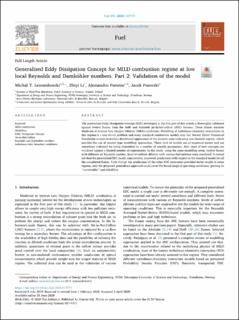| dc.contributor.author | Lewandowski, Michal | |
| dc.contributor.author | Li, Zhiyi | |
| dc.contributor.author | Parente, Alessandro | |
| dc.contributor.author | Pozorski, Jacek | |
| dc.date.accessioned | 2021-03-08T10:05:15Z | |
| dc.date.available | 2021-03-08T10:05:15Z | |
| dc.date.created | 2020-08-10T16:41:38Z | |
| dc.date.issued | 2020 | |
| dc.identifier.citation | Fuel. 2020, 278 . | en_US |
| dc.identifier.issn | 0016-2361 | |
| dc.identifier.uri | https://hdl.handle.net/11250/2732099 | |
| dc.description.abstract | The generalised Eddy Dissipation Concept (EDC) developed in the first part of this article is thoroughly validated against twelve flames from the Delft and Adelaide jet-in-hot-coflow (JHC) burners. These flames emulate Moderate or Intense Low Oxygen Dilution (MILD) conditions. Modelling of turbulence-chemistry interactions in this regime is a non trivial problem and many standard combustion models may fail. Recent Direct Numerical Simulation studies revealed a distributed appearance of the reaction zone indicating non-flamelet regime, which justified the use of reactor type modelling approaches. Those kind of models are of empirical nature and are sometimes criticized for being dependent on a number of tunable parameters. Also, most of new concepts are validated against a limited number of experiments. In this study, using the same modelling setup, twelve flames with different jet Reynolds number, level of oxidizer dilution with various fuel mixture were simulated. It turned out that the generalised EDC model considerably improved predictions with respect to the standard model for all the considered flames. Even though the predictions of the other EDC extensions provided better results in some regions, only the proposed generalised approach could cover the broad tange of operating conditions, proving its “universality” and reliability | en_US |
| dc.language.iso | eng | en_US |
| dc.publisher | Elsevier | en_US |
| dc.rights | Navngivelse 4.0 Internasjonal | * |
| dc.rights.uri | http://creativecommons.org/licenses/by/4.0/deed.no | * |
| dc.title | Generalised Eddy Dissipation Concept for MILD combustion regime at low local Reynolds and Damköhler numbers. Part 2: Validation of the model | en_US |
| dc.type | Peer reviewed | en_US |
| dc.type | Journal article | en_US |
| dc.description.version | publishedVersion | en_US |
| dc.source.pagenumber | 16 | en_US |
| dc.source.volume | 278 | en_US |
| dc.source.journal | Fuel | en_US |
| dc.identifier.doi | 10.1016/j.fuel.2020.117773 | |
| dc.identifier.cristin | 1822581 | |
| dc.description.localcode | 0016-2361/ © 2020 The Author(s). Published by Elsevier Ltd. This is an open access article under the CC BY license (http://creativecommons.org/licenses/BY/4.0/). | en_US |
| cristin.ispublished | true | |
| cristin.fulltext | original | |
| cristin.qualitycode | 2 | |

